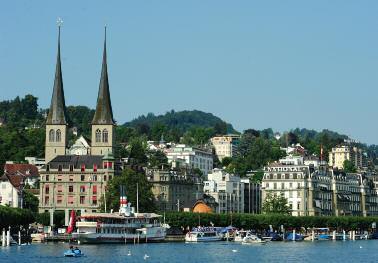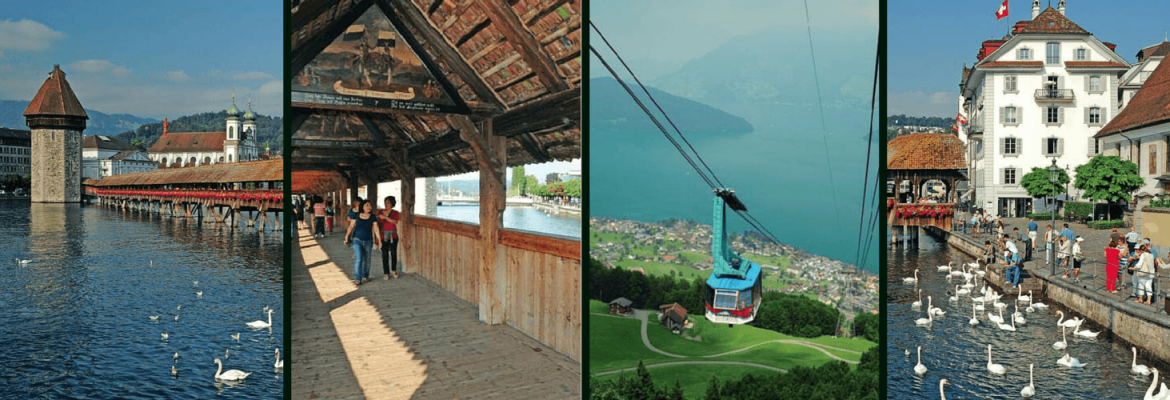THERE ARE two ways to cross the mouth of the River Reuss in the centre of Lucerne. You can join the trams, taxis and traffic on the new concrete bridge, or step on to the geranium-bedecked medieval covered wooden footbridge and stroll across to the old town admiring both the view and the paintings on the eaves of the roof at intervals along its diagonal route.
Take the Chapel Bridge with its 17th century paintings every time. It’s a couple of hundred yards further to walk but a privilege to follow in centuries of footsteps and marvel at Switzerland’s most-photographed icon.
The bridge and the connected octagonal water tower next to it make Lucerne instantly recognisable.
At the Western end of Lake Lucerne, the town spreads along both banks of the lake and the river. The Chapel Bridge crosses just where the lake narrows and the Reuss takes over as the water rushes into it. Further along there are more footbridges connecting the two parts of town, including the wooden Mill Bridge with more paintings. From those bridges you do get an impression of the power of the water. Its speed increases as the river narrows and there’s a good view of the torrent as it plunges over foaming weirs and away.
The Water Tower and the Chapel Bridge, both built around 1300, are Lucerne’s trademarks. The oldest preserved wooden bridge in Europe displays a series of 17th century paintings on triangular panels under its eaves. A major part of the bridge, including the paintings, was almost completely destroyed by fire in 1993. The reconstructed bridge was reopened six months later.
Since then, many of the paintings have been replaced or recopied. The octagonal Water Tower, like the Chapel Bridge, formed part of the inner city fortifications and has served as an archive, a city treasury and a prison.

Lucerne is the capital of the canton of Lucerne and in many respects the most important city in Central Switzerland.
There was probably a small settlement here near the lake during Roman times or earlier. The St Leodegar monastery has existed since the early eighth century. An important marketplace developed around the Reuss Bridge, which connected the monastery with the feudal court to the south.
Lucerne is also a city of palaces, churches, and squares. In the late Middle Ages passion plays were performed on the Weinmarkt square. The city instituted a public market hall on the Kornmarkt around 1370. This also served as a storage house for grain and was later converted into a town hall.
The Hof Church, the Town Hall and the Rittersche Palace are important monuments dating from the late Renaissance, while the Jesuit Church is one of Switzerland’s finest baroque churches. The Franciscan Church is considered to be the finest Gothic church in Central Switzerland. Lucerne remained a small medieval town until the end of the 18th century, but with the beginning of tourism around 1830, it began to change and grow.
On the afternoon of August 25, 1938, Arturo Toscanini conducted Richard Wagner’s Siegfried Idyll in the park at Tribschen before an audience of 1200people. The music and venue had been specially chosen, because it was at his country house in Tribschen that Wagner enjoyed the happiest and most fruitful period of his life. Toscanini’s concert inaugurated the Lucerne Festival (formerly known as the International Music Festival of Lucerne). Since then, music-lovers from all over the world have been drawn to Lucerne every year.
Lucerne also has a dynamic art scene, typified by the art museum inside theCulture and Convention Centre. A boat ride on Lake Lucerne, which has the most extensive inland navigation system in Europe, is essential. The panorama boat, the five paddle steamers or the elegant catamaran ply the blue waters of Lake Lucerne surrounded by the green foothills and the mountain peaks.

